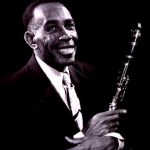Along with trumpeter Bunk Johnson, New Orleans clarinetist George Lewis rose to prominence during an era jazz historians have deemed the Second Trad Jazz Revival: a period from the mid-40s to the mid-60s where technological and industrial advancements in the recording industry “introduced” audiences world-wide to the sounds of musicians, whose efforts, despite playing a formative role in jazz’s nascent stages, had largely gone unnoticed.
Born in 1900, Lewis began performing professionally prior to the end of World War I and found regular employment as a sideman to greats such as trumpeter Buddie Petit and trombonist Edward “Kid” Ory. But, it wasn’t until Lewis’ appearance on fellow, longtime New Orleans sideman Johnson’s first recording in 1942 that audiences outside of New Orleans would hear Lewis’ fervent yet subtle tone. Two years later, Lewis’ first recording session fronting his own ensemble brought with it the indelible classic “Burgundy Street Blues.” Over the course of the next two decades, Lewis’ career flourished, and by the time of his passing in 1968, he left with jazz a legacy that will never go unnoticed.
Today, traditional jazz pianist Lars Edegran, who oversees the George H. Buck Jr. Jazz Foundation’s recording archives, has (with the input of an internationally renowned committee of jazz musicians, record label representative, historians, authors and record collectors) culled together the two-disc set The Best of George Lewis: 1943-64. For the Swedish-born Edegran, the project brings him full circle with man whom he made his recording debut alongside nearly 50 years ago… as well as the friend who gave the then young, aspiring pianist a job as a painter so that he could get his his feet on ground.
Tune in below to hear this fascinating story…
[powerpress=”https://www.offbeat.com/wp-content/uploads/powerpress/2013/06/lars-edegran-look-ka-py-py-podcast.m4a”]





